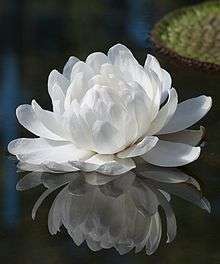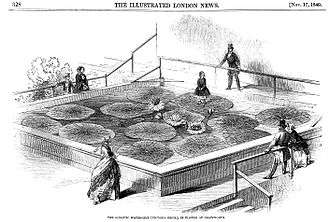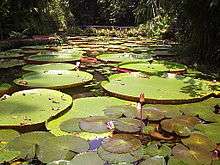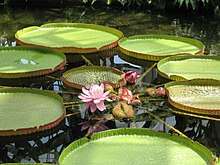Victoria amazonica
Victoria amazonica is a species of flowering plant, the largest of the Nymphaeaceae family of water lilies. It is the National flower of Guyana.
| Queen Victoria's water lily | |
|---|---|
 | |
| Victoria amazonica at the Adelaide Botanic Garden, South Australia | |
| Scientific classification | |
| Kingdom: | Plantae |
| Clade: | Tracheophytes |
| Clade: | Angiosperms |
| Order: | Nymphaeales |
| Family: | Nymphaeaceae |
| Genus: | Victoria |
| Species: | V. amazonica |
| Binomial name | |
| Victoria amazonica | |
| Synonyms[1][2][3] | |
| |
Description
The Victoria amazonica has very large leaves, up to 3 m (10 ft) in diameter, that float on the water's surface on a submerged stalk, 7–8 m (23–26 ft) in length. It is the largest waterlily in the world. V. amazonica is native to the shallow waters of the Amazon River basin, such as oxbow lakes and bayous. Flowers take up to 48 hours to fully open. The flowers are white the first night they are open and become pink the second night. They are up to 40 cm (16 in) in diameter, and are pollinated by beetles. This process was described in detail by Sir Ghillean Prance and Jorge Arius.[4] [5]
The species was once called Victoria regia after Queen Victoria, but the name was superseded. It is depicted in the Guyanese coat of arms.[6]
Classification
_(1851).jpeg)
A member of the genus Victoria placed in the Nymphaeaceae family or, sometimes, in the Euryalaceae.[7] The first published description of the genus was by John Lindley in October 1837, based on specimens of this plant returned from British Guiana by Robert Schomburgk. Lindley named the genus after the newly ascended Queen Victoria, and the species Victoria regia.[1] The spelling in Schomburgk's description in Athenaeum, published the month before, was given as Victoria Regina.[2] Despite this spelling being adopted by the Botanical Society of London for their new emblem, Lindley's was the version used throughout the nineteenth century.[3][8]
An earlier account of the species, Euryale amazonica by Eduard Friedrich Poeppig, in 1832 described an affinity with Euryale ferox. A collection and description was also made by the French botanist Aimé Bonpland in 1825.[1][1][9] In 1850 James De Carle Sowerby[10] recognised Poeppig's earlier description and transferred its epithet amazonica. The new name was rejected by Lindley. The current name, Victoria amazonica, did not come into widespread use until the twentieth century.[3]
History

Victoria regia, as it was named, was described by Tadeáš Haenke in 1801.[11] It was once the subject of rivalry between Victorian gardeners in England. Always on the look out for a spectacular new species with which to impress their peers, Victorian "Gardeners"[12] such as the Duke of Devonshire, and the Duke of Northumberland started a well-mannered competition to become the first to cultivate and bring to flower this enormous lily. In the end, the two aforementioned Dukes became the first to achieve this, Joseph Paxton (for the Duke of Devonshire) being the first in November 1849 by replicating the lily's warm swampy habitat (not easy in winter in England with only coal-fired boilers for heating), and a "Mr Ivison" the second and more constantly successful (for Northumberland) at Syon House.
The species captured the imagination of the public, and was the subject of several dedicated monographs. The botanical illustrations of cultivated specimens in Fitch and W.J. Hooker's 1851 work Victoria Regia[13] received critical acclaim in the Athenaeum, "they are accurate, and they are beautiful".[14] The Duke of Devonshire presented Queen Victoria with one of the first of these flowers, and named it in her honour. The lily, with ribbed undersurface and leaves veining "like transverse girders and supports", was Paxton's inspiration for The Crystal Palace, a building four times the size of St. Peter's in Rome.[15]
Gallery
.jpg) Underside of a leaf
Underside of a leaf.jpg) Underside of a leaf
Underside of a leaf Leaf
Leaf Flower bud, Adelaide Botanic Gardens
Flower bud, Adelaide Botanic Gardens Flower
Flower In Botanical garden Brno
In Botanical garden Brno.jpg) In Kobe Kachoen
In Kobe Kachoen In the Adelaide Botanic Gardens
In the Adelaide Botanic Gardens In Paraense Emílio Goeldi Museum
In Paraense Emílio Goeldi Museum In Phipps Conservatory and Botanical Gardens, Pittsburgh
In Phipps Conservatory and Botanical Gardens, Pittsburgh Victoria Regia in bloom in the Hortus Botanicus Leiden at the end of the 19th century
Victoria Regia in bloom in the Hortus Botanicus Leiden at the end of the 19th century Victoria Amazonica - Giant water lilies in the Amazon basin near Manaus, Brazil
Victoria Amazonica - Giant water lilies in the Amazon basin near Manaus, Brazil Giant water lilies in the Amazon basin near Manaus, Brazil
Giant water lilies in the Amazon basin near Manaus, Brazil A bird on Victoria Amazonica Giant water lily near Manaus, Brazil
A bird on Victoria Amazonica Giant water lily near Manaus, Brazil
References
- Knotts, Kit. "Victoria's History". Victoria Adventure. Knotts. Archived from the original on 2009-04-14. Retrieved 2009-04-04.
- R.H.Schomb., Athenaeum 515:661. Sep 9. 1837
- Trehane, Piers; Pagels, Walter (2001). "Victoria Regia or Victoria Regina? How A Politics Can Change A Waterlily Name". Letters. (cited at GRIN). Victoria Adventure. Archived from the original on 2009-08-13. Retrieved 2009-04-04.
- Prance, Ghillean T. & Jorge R. Arius. A study of the floral biology of Victoria amazonica (Poepp.) Sowerby (Nymphaeaceae). Acta Amazonica 5 (2): 109-139. 1975.
- "Myths and Misunderstandings About Victoria". www.victoria-adventure.org. Archived from the original on 15 August 2017. Retrieved 25 November 2017.
- Knotts, Kit. "Victoria's history". Water Gardeners International. Retrieved 10 August 2020.
- "Genus: Victoria Lindl". Germplasm Resources Information Network. United States Department of Agriculture. 27 Jan 2005. Archived from the original on 2009-08-13. Retrieved 2009-04-04.
- Opitz, Donald L. (21 June 2013). "'The sceptre of her pow'r': nymphs, nobility, and nomenclature in early Victorian science". The British Journal for the History of Science. 47 (1): 67–94. doi:10.1017/S0007087413000319.
- "Nymphaeaceae Victoria Lindl". Plant Name Details. International Plant Name Index. 2005. Archived from the original on 2009-08-13. Retrieved 2009-04-04.
- Ann. Mag. Nat. Hist., Ser. 2, 6, 310
- "Sonderausstellung 2004 | BGBM". Bgbm.org. Archived from the original on 2016-11-03. Retrieved 2016-11-02.
- In reality they did little or no actual gardening at all, but employed talented horticulturalists such as Joseph Paxton (for Devonshire) and the forgotten Mr Ivison (for Northumberland) to run their estates and gardens.
- "Victoria Regia : or, Illustrations of the Royal water-lily, in a series of figures chiefly made from specimens flowering at Syon and at Kew by Walter Fitch; with descriptions by Sir W. J. Hooker. ".
- Allibone, Samuel Austin (1863). A critical dictionary of English literature and British and American authors. 1. George W. Childs.
- H. Peter Loewer. The Evening Garden: Flowers and Fragrance from Dusk Till Dawn. Timber Press, 2002. ISBN 978-0-88192-532-6. Page 130.
External links

